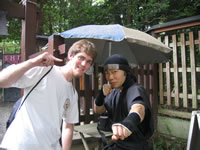


NanoJapan Overview
My research project consisted of an explorative computer model to estimate material deposition patterns on surfaces that weren’t flat, real-world testing using a combination scanning electric microscope(SEM)/focused ion beam(FIB) machine and an evaporative vapor deposition chamber I was taught to run, and finally visualizing and analyzing the deposition pattern using the SEM function of the machine. I had not done any research in nanotechnology before, but this project meshed well with my interests in developing computer models and verifying them with experimental methods.
Working internationally at LASIE was actually not much different from working in a lab in the US because most presentations and graduate students could speak English, but certain cultural differences such as the Japanese respect for the chain of command and ambivalence to long, awkward pauses were very noticeable. This was by far my most interesting research experience, however, because I was able to conduct the project from beginning to end like a graduate student, reporting to my direct research advisor Yuika Saito often and finding help when I needed it. I firmly decided after enjoying this project so much that I needed to at least go after my masters degree if not a PhD as well.
Meaning of NanoJapan
I think that the NanoJapan program provides an invaluable experience to students in engineering and physics by allowing us to participate in an international research internship for almost no cost. I have looked into international internships and job opportunities before, and into possibly studying abroad, but each of these programs imposes a considerable cost on students. I had a lot of trouble deciding what to do for the summer of 2007 because I wanted to have an international internship of some kind or work at a research lab through the REU program, so I jumped at the chance to join NanoJapan and be able to do both. I had studied Japanese before the program, and was able to continue studying Japanese to work towards a certificate in International Engineering here at UW-Madison.
Daily Life in Japan
I would generally arrive at the lab around 8:00 and work until 5:00 or 6:00 with a break in the middle to have lunch in the cafeteria with the graduate students in my research group. This may sound like a formidable schedule, but it is an unwritten rule that we were to spend most of our time in the lab offices even though we would generally work on and off throughout the day in the labs as well.
During the weekends I was able to travel a lot using the local train system to see almost all of southern Honshu, including sake tasting in Kobe, hiking through Koyasan and Kyoto, visiting Himeji Castle, and even experiencing a “ninja village” in Iga Ueno. During these weekend trips I was able to talk with locals who didn’t speak much English, and met several Japanese hikers out on trails. These travels culminated in several of the NanoJapan 2007 students climbing Mount Fuji together in time to catch the sunrise; an experience that I’ll never forget. This climb can be as easy as taking a bus half-way up or as difficult as climbing from the ancient temple at its base, but either way I’d highly recommend making an effort to experience Mount Fuji.
My favorite experience in Japan was...
Definitely hiking around the rural areas and climbing Mount Fuji. The train system in Japan allows you to cheaply travel all around the country, and the incredible number of shrines, temples, and locals that you’ll find tucked away in the mountainside make for an unforgettable experience.
Before I left for Japan I wish I had...
Gotten a better camera. There were many times in the lab and on weekend trips were I wasn’t able to document my trip for myself because I was running out of battery or space.